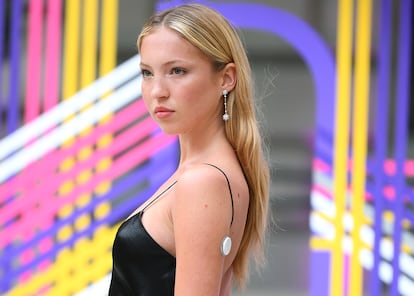The rise of glucose sensors among non-diabetics: Self-care or a status symbol?
More and more non-diabetics are measuring their glucose spikes with sensors that make health monitoring the ultimate privilege. Is it a form of health consciousness or an unjustified obsession?

A couple of months ago, The Wall Street Journal asked what a Hollywood star, an Olympic medalist and a Harvard longevity researcher had in common. The answer was their “obsession” with controlling glucose and the sensors that monitor blood-sugar levels. The sensors are small devices that are usually placed on the back of the arm to constantly measure the concentration of glucose in the interstitial fluid.
Until recently these sensors were used only by people with diabetes, especially by those with Type I, whose pancreas stops functioning normally for reasons that science has not yet been able to explain. However, it has become increasingly common for those who do not suffer from the condition to use these monitors too.
Thus, one more concern can be added to the endless list of existing neuroses, which has caused some to wonder if glucose is the new gluten. There is also talk of sensors as the ultimate status symbol: they cost between $100 and $300 per month, and are not covered by health insurance. The rising use of glucose sensors has upset people who have to wear such monitors as a means of dealing with a dysfunctional pancreas.
As part of this new obsession with glucose, gurus like Jessie Inchauspé — better known as the Glucose Goddess — have emerged on social media, offering tips to control and minimize glucose spikes. The purpose of her method is not to lose weight, but to learn to eat in a specific order that benefits glucose control. Inchauspé, who is not diabetic, has created a real business around controlling blood-sugar control. She has two best-selling books, an online course that costs around $2,500, a video podcast, and an Instagram account with more than three million followers (with Karlie Kloss, Orlando Bloom, and, of course, Gwyneth Paltrow among them).
In May, a supplement goes on sale that (allegedly) minimize sugar increases by 40%. It costs $53. For now, it is recommended that diabetics not take it without consulting their doctor, so it is not known if it really is effective or if it is a placebo for healthy people. Inchauspé acknowledges that she has received a lot of criticism for using glucose sensors despite not being diabetic, so in 2022 she began to distance herself from the devices. “I got a lot of messages from people who have Type 1 diabetes who said, ‘Jessie, this is so offensive that you would post this as a fashion statement when [I] need this to live.’ So I was like, ‘I never thought about that,’” she explained to The Wall Street Journal. Since then, she only uses a monitor a couple of times a year for a couple of weeks.
Glucose sensors have also gradually entered popular culture thanks to models such as Laura Sánchez and Lila Grace Moss, the daughter of Kate Moss, who posed with her sensor in a Fendi campaign. They both suffer from Type I diabetes and need the sensors to be able to control how much insulin they need to inject at any given time. On social media, they have normalized wearing a sensor, which has been highly applauded by the parents of young people with the disease. They have to deal with their children’s insecurities that come from wearing a device attached to their skin.
There has also been a boom in TikTok videos in which creators are seen unpacking ZOE type sensors. These sensors are used by thousands of people who meticulously control their glucose levels despite not being diabetic themselves.
But is it useful for non-diabetics to worry about their glucose levels?
“Type II diabetes — not to be confused with Type I, for which we do not know the cause — is usually preceded by prediabetes due to continuous glucose spikes that create insulin resistance in the body and a residual chronic need for insulin that can trigger the pathology. It is not something that happens overnight, but healthy people also have glucose spikes, and when these occur continuously, over the years, they can generate symptoms of predisposition to prediabetes and later Type II diabetes. We have detected worrying patterns in many people who thought they were healthy, but whose habits for many years had created insulin resistance like generating very high peaks followed by a slower return to normal levels,” Alberto Conde Mellado responds. He is the founder of Glucovibes, a digital metabolic GPS that objectively extracts indicators from the body to understand how it works inside and detect metabolic problems responds.
Many health professionals are asking whether this unnecessary control can have negative consequences. “Taking care of yourself is always advisable, but, like everything else, it can become a pathology if taken to extremes,” Manuel Hernández, President of the Spanish Association of Psychological Trauma and creator of the Parcuve Model, explains to EL PAÍS. “In this case, the illness is mental. Therefore, if the devices are used appropriately to take care of sugar levels in a person who has high blood-sugar, there is no problem. But if it is done obsessively or without a real need, we must assess whether there may be a psychological disorder behind it that may be an Obsessive-Compulsive Disorder (OCD).”
“If a person has diabetes and monitors their sugar levels frequently, it is healthy and appropriate, but if someone uses these sensors to monitor what they eat and does so very frequently or excessively, without a doubt we can say that they have OCD. The problem does not lie in using a sensor. What is worrying is the reason why it is used and the frequency with which it is done,” he adds.
A new status symbol
Status symbols are a great way to measure the zeitgeist, and the interest in controlling one’s health underlines the individualism that characterizes today’s society. From applications that measure the quality of our sleep to daily step counters, the opportunity to measure aspects that we did not think about before reinforces the idea that our health is our responsibility, so good health is now a privilege and for some privileged people, taking absolute control over their health has become a hobby.
“At Glucovibes we bring all of a person’s lifestyle information together, and the sensor helps us ‘calibrate’ each of our clients individually and learn what the response of their metabolic system will be at different times of the day and to different stimuli such as nutrition, exercise and rest,” says Alberto Conde Mellado. “Using a sensor with a cellphone application designed for people with diabetes may not be the most appropriate option for a healthy person. However, using this information as physiological data about your metabolism can provide many benefits to extend concentration levels, manage weight, improve rest, or learn about patterns induced by lifestyle that can be improved. Above all it can prevent possible future metabolic irregularities due to current habits.”
The former footballer and coach Luis Enrique is a Glucovibes user, and he spoke about the company live on his social media without having any kind of contract with the brand. “Do you see this patch I have here? It is a patch that shows glucose. That is, your blood-sugar level depending on what you have eaten,” he said. “I really like knowing that when you have a sugar spike, glucose rises and the pancreas has to secrete insulin to lower that level, because it is not great for our health. With it, I can clearly see what sugar spikes I have, depending on what I eat. If I suddenly overdo something and see that I’m not feeling very good, I look at it on the chart and I can see what’s happening. It is very useful for anyone who is interested in their health and for all of you who do endurance sports, because during the race, you can see your glucose peaks, and supplement accordingly.”
Although the sensors that so many non-diabetics use are intended to monitor health, as Barbara Ehrenreich writes in Natural Causes, a book that addresses the way we deal with well-being and death, “no matter how hard we try: we can’t control everything, not even our body and mind.”
In the end, glucose sensors can help us monitor our health, but they can also become self-monitoring traps that only a few can afford — many Type I diabetics live in countries where medical care is not free, and they cannot access these sensors. And this is no joke. Women who develop Type I diabetes before the age of 10 have an average life expectancy that is 18 years shorter than non-diabetic women. In the case of men, their average lifespan is 14 years shorter, according to the results of a study published in The Lancet. When health and controlling it are a luxury, we have to be careful. Talking about the glucose sensor like it is the newest trend in designer handbags can be a delicate matter for those who need it to survive, not to show off.
Sign up for our weekly newsletter to get more English-language news coverage from EL PAÍS USA Edition
Tu suscripción se está usando en otro dispositivo
¿Quieres añadir otro usuario a tu suscripción?
Si continúas leyendo en este dispositivo, no se podrá leer en el otro.
FlechaTu suscripción se está usando en otro dispositivo y solo puedes acceder a EL PAÍS desde un dispositivo a la vez.
Si quieres compartir tu cuenta, cambia tu suscripción a la modalidad Premium, así podrás añadir otro usuario. Cada uno accederá con su propia cuenta de email, lo que os permitirá personalizar vuestra experiencia en EL PAÍS.
¿Tienes una suscripción de empresa? Accede aquí para contratar más cuentas.
En el caso de no saber quién está usando tu cuenta, te recomendamos cambiar tu contraseña aquí.
Si decides continuar compartiendo tu cuenta, este mensaje se mostrará en tu dispositivo y en el de la otra persona que está usando tu cuenta de forma indefinida, afectando a tu experiencia de lectura. Puedes consultar aquí los términos y condiciones de la suscripción digital.
More information
Archived In
Últimas noticias
Most viewed
- Sinaloa Cartel war is taking its toll on Los Chapitos
- Oona Chaplin: ‘I told James Cameron that I was living in a treehouse and starting a permaculture project with a friend’
- Reinhard Genzel, Nobel laureate in physics: ‘One-minute videos will never give you the truth’
- Why the price of coffee has skyrocketed: from Brazilian plantations to specialty coffee houses
- Silver prices are going crazy: This is what’s fueling the rally











































